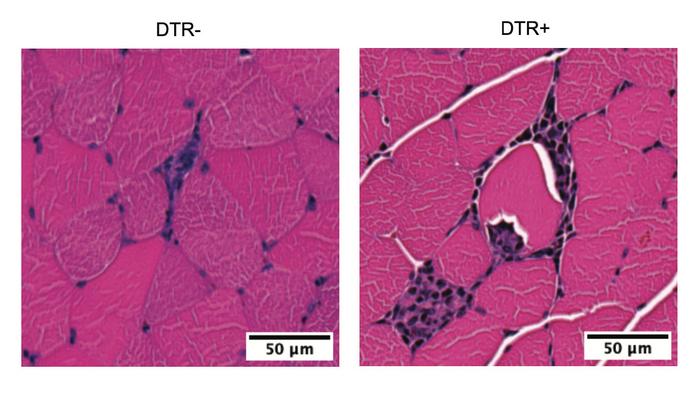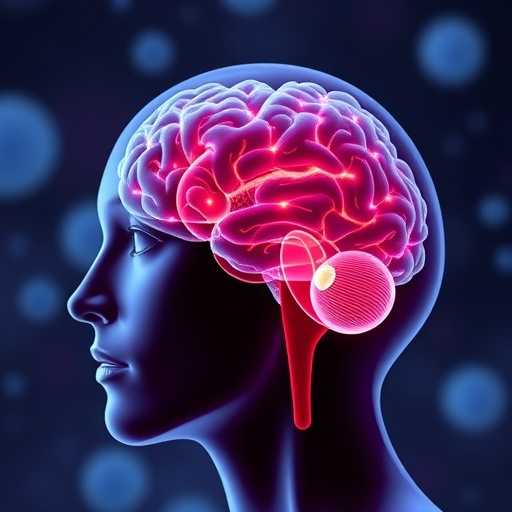The connection between exercise and inflammation has captivated the imagination of researchers ever since an early 20th-century study showed a spike of white cells in the blood of Boston marathon runners following the race.

Credit: Credit: Kent Langston/Mathis Lab, HMS
The connection between exercise and inflammation has captivated the imagination of researchers ever since an early 20th-century study showed a spike of white cells in the blood of Boston marathon runners following the race.
Now, a new Harvard Medical School study published Nov. 3 in Science Immunology may offer a molecular explanation behind this century-old observation.
The study, done in mice, suggests that the beneficial effects of exercise may be driven, at least partly, by the immune system. It shows that muscle inflammation caused by exertion mobilizes inflammation-countering T cells, or Tregs, which enhance the muscles’ ability to use energy as fuel and improve overall exercise endurance.
Long known for their role in countering the aberrant inflammation linked to autoimmune diseases, Tregs now also emerge as key players in the body’s immune responses during exercise, the research team said.
“The immune system, and the T cell arm in particular, has a broad impact on tissue health that goes beyond protection against pathogens and controlling cancer. Our study demonstrates that the immune system exerts powerful effects inside the muscle during exercise,” said study senior investigator Diane Mathis, Morton Grove-Rasmussen Professor of Immunology in the Blavatnik Institute at HMS.
Mice are not people, and the findings remain to be replicated in further studies, the researchers cautioned. However, the study is an important step toward detailing the cellular and molecular changes that occur during exercise and confer health benefits.
Understanding the molecular underpinnings of exercise
Protecting from cardiovascular disease, reducing the risk of diabetes, shielding against dementia. The salutary effects of exercise are well established. But exactly how does exercise make us healthy? The question has intrigued researchers for a long time.
The new findings come amid intensifying efforts to understand the molecular underpinnings of exercises. Untangling the immune system’s involvement in this process is but one aspect of these research efforts.
“We’ve known for a long time that physical exertion causes inflammation, but we don’t fully understand the immune processes involved,” said study first author Kent Langston, a postdoctoral researcher in the Mathis lab. “Our study shows, at very high resolution, what T cells do at the site where exercise occurs, in the muscle.”
Most previous research on exercise physiology has focused on the role of various hormones released during exercise and their effects on different organs such as the heart and the lungs. The new study unravels the immunological cascade that unfolds inside the actual site of exertion — the muscle.
T cell heroes and inflammation-fueling villains
Exercise is known to cause temporary damage to the muscles, unleashing a cascade of inflammatory responses. It boosts the expression of genes that regulate muscle structure, metabolism, and the activity of mitochondria, the tiny powerhouses that fuel cell function. Mitochondria play a key role in exercise adaptation by helping cells meet the greater energy demand of exercise.
In the new study, the team analyzed what happens in cells taken from the hind-leg muscles of mice that ran on a treadmill once and animals that ran regularly. Then, the researchers compared them with muscle cells obtained from sedentary mice.
The muscle cells of the mice that ran on treadmills, whether once or regularly, showed classic signs of inflammation — greater activity in genes that regulate various metabolic processes and higher levels of chemicals that promote inflammation, including interferon.
Both groups had elevated levels of Treg cells in their muscles. Further analyses showed that in both groups, Tregs lowered exercise-induced inflammation. None of those changes were seen in the muscle cells of sedentary mice.
However, the metabolic and performance benefits of exercise were apparent only in the regular exercisers — the mice that had repeated bouts of running. In that group, Tregs not only subdued exertion-induced inflammation and muscle damage, but also altered muscle metabolism and muscle performance, the experiments showed. This finding aligns with well-established observations in humans that a single bout of exercise does not lead to significant improvements in performance and that regular activity over time is needed to yield benefits.
Further analyses confirmed that Tregs were, indeed, responsible for the broader benefits seen in regular exercisers. Animals that lacked Tregs had unrestrained muscle inflammation, marked by the rapid accumulation of inflammation-promoting cells in their hindleg muscles. Their muscle cells also had strikingly swollen mitochondria, a sign of metabolic abnormality.
More importantly, animals lacking Tregs did not adapt to increasing demands of exercise over time the way mice with intact Tregs did. They did not derive the same whole-body benefits from exercise and had diminished aerobic fitness.
These animals’ muscles also had excessive amounts of interferon, a known driver of inflammation. Further analyses revealed that interferon acts directly on muscle fibers to alter mitochondrial function and limit energy production. Blocking interferon prevented metabolic abnormalities and improved aerobic fitness in mice lacking Tregs.
“The villain here is interferon,” Langston said. “In the absence of guardian Tregs to counter it, interferon went on to cause uncontrolled damage.”
Interferon is known to promote chronic inflammation, a process that underlies many chronic diseases and age-related conditions and has become a tantalizing target for therapies aimed at reducing inflammation. Tregs have also captured the attention of scientists and industry as treatments for a range of immunologic conditions marked by abnormal inflammation.
The study findings provide a glimpse into the cellular innerworkings behind exercise’s anti-inflammatory effects and underscore its importance in harnessing the body’s own immune defenses, the researchers said.
There are efforts afoot to design interventions targeting Tregs in the context of specific immune-mediated diseases. And while immunologic conditions driven by aberrant inflammation require carefully calibrated therapies, exercise is yet another way to counter inflammation, the researchers said.
“Our research suggests that with exercise, we have a natural way to boost the body’s immune responses to reduce inflammation,” Mathis said. “We’ve only looked in the muscle, but it’s possible that exercise is boosting Treg activity elsewhere in the body as well.”
Authorship, funding, disclosures
Co-investigators included Yizhi Sun, Birgitta Ryback, Bruce Spiegelman, Amber Mueller, and Christophe Benoist.
The work was funded by National Institutes of Health grants R01 AR070334, F32 AG072874, and F32 AG069363; and by the JPB Foundation.
Journal
Science Immunology
DOI
10.1126/sciimmunol.adi5377
Method of Research
Experimental study
Subject of Research
Animals
Article Title
Regulatory T cells shield muscle mitochondria from interferon--mediated damage to promote the beneficial effects of exercise
Article Publication Date
3-Nov-2023




